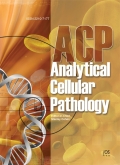Authors: Kayser, Klaus | Richter, Barbara | Stryciak, Richard | Gabius, Hans‐Joachim
Article Type:
Research Article
Abstract:
Combined measurements of integrated nuclear fluorescence (INF) and vascularization were performed on surgical specimens of human lung carcinomas. Histological slides of formalin‐fixed, paraffin‐embedded tissue samples were treated with Texas Red‐labeled antibody to factor VIII and the fluorochrome DAPI. The resulting images were analyzed with an epi‐illumination fluorescence microscope and two different filter blocks. The first image displayed the vessels, and the second the DAPI‐stained nuclei of surrounding cells. The extent of vascularization was assessed by calculating the volume fraction (Vv), the surface fraction (Sv), the area, and the minimum diameter of the vessels. The INF was measured in tumour cells
…and lymphocytes, and was grouped according to the distance from the nearest vascular boundary into the intervals of 0–20, 21–40, 41–60, 61–80, and > 80 \mu . The numerical densities (Nv) as well as the percentages of S‐phase‐related tumour cell fraction (SPRF) and of tumour cells with an INF > 5C were computed. A minimum of 50 vessels and 300 tumour cells were examined. The material included 100 cases with primary lung carcinoma (39 epidermoid carcinomas, 39 adenocarcinomas, 13 large cell carcinomas, three small cell anaplastic carcinomas, and 6 carcinoid tumours). On the average, the volume density of the stroma amounts to 16.7%, and that of the vessels (Vv) to 12.8%. The minimum diameter of the intratumoral vessels is 13 \mu and the measured circumference 138 \mu . The numerical densities of tumour cells (lymphocytes) decrease with increasing distance from the vascular boundary from 6.3 (1.7) to 1.0 (0.1). A reduction is also seen in the percentage of the SPRF from 10.7 to 8.1%. The percentage of tumour cells with an INF > 5C, however, is positively correlated to the distance from the vascular surfaces from 34.2 to 38.2%. The measurements reveal that tumour cells are densely positioned and have an increased proportion of proliferation in the populations close to perivascular spaces, whereas chromosome abnormalities are seen more frequently, when tumour cells are located at a distance > 20 \mu from the vascular surfaces.
Show more
Keywords: Lung carcinoma, vascularization, integrated nuclear fluorescence, S‐phase‐related tumour cell fraction, numerical density
Citation: Analytical Cellular Pathology,
vol. 15, no. 2, pp. 73-83, 1997
Price: EUR 27.50





